Exclusive 2019 Update: VICTORY AT THE VA – West LA Veterans Administration master plan protects old nuclear dump from development
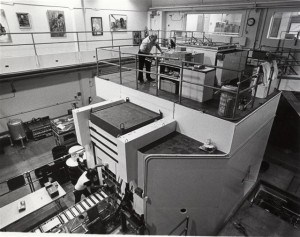 Left – UCLA Reactor:
Left – UCLA Reactor:
[October 16, 2017 – While EnviroReporter.com‘s reporting on the Brentwood biomedical nuclear dump partially under Barrington Dog Park stopped then-President George W. Bush’s $4 billion plan to privatize and develop VA land, nothing has been remediated.]
In August of 1958, plans are completed for UCLA to receive an accident-proof nuclear reactor worth $203,350 from the Atomic Energy Commission. UCLA is one of the first universities in the country to receive the 10-kilowatt Argonaut reactor, which will run for more than 10 years on three kilograms of Uranium-235 loaned to UCLA by the AEC.
In March of 1981, the Argonaut research reactor is up for relicensing, while at the same time it comes under attack from a campus-community anti-nuclear group called Committee to Bridge the Gap. The Nuclear Regulatory Commission recently denied the group’s petition to close down the reactor because of perceived safety risks.
In June of 1984, it is announced that UCLA will decommission its training and research reactor and that the Nuclear Regulatory Commission has been notified that UCLA will withdraw its application to renew the operating license for the reactor. The reactor operated safely from startup in 1960 through shutdown on Feb. 3, 1984 under pressure from Committee to Bridge the Gap.
(Click thumbnail to view entire photograph)
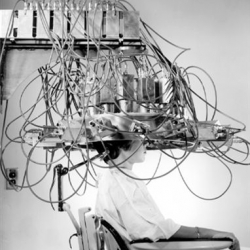 Positron emitter detector used to
detect brain tumors at Brookhaven
National Laboratory (circa 1962).
Positron emitter detector used to
detect brain tumors at Brookhaven
National Laboratory (circa 1962).
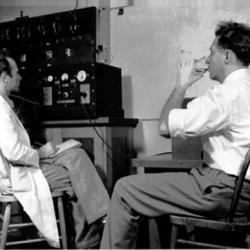 Joseph Hamilton, left, conducting one of the
first isotope metabolism studies during the
1930s. The study took place at the Lawrence
Radiation Laboratory (now Lawrence
Berkeley Laboratory). The test subject on the
right is drinking a "radiation cocktail."
Joseph Hamilton, left, conducting one of the
first isotope metabolism studies during the
1930s. The study took place at the Lawrence
Radiation Laboratory (now Lawrence
Berkeley Laboratory). The test subject on the
right is drinking a "radiation cocktail."
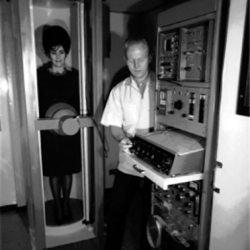 A mobile whole body counter (circa
1966)
A mobile whole body counter (circa
1966)
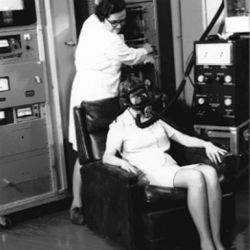 Respiration analysis using
radioactive tracers at Donner
Laboratory (circa 1968).
Respiration analysis using
radioactive tracers at Donner
Laboratory (circa 1968).
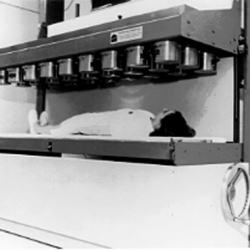 Brookhaven Low-Level Whole Body Counting
Facility (circa 1968).
Brookhaven Low-Level Whole Body Counting
Facility (circa 1968).
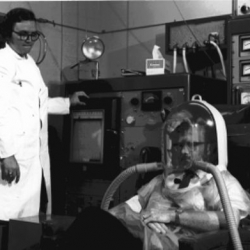 Radiation administrator at Donner Laboratory
releasing gas from a carbon-14 inhalation
apparatus in a metabolic study.
Radiation administrator at Donner Laboratory
releasing gas from a carbon-14 inhalation
apparatus in a metabolic study.
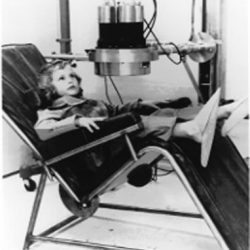 A Richland, Washington child
participating in a program to measure
radiation typically present in the body.
This 1960s project took place at
Pacific Northwest Laboratory.
A Richland, Washington child
participating in a program to measure
radiation typically present in the body.
This 1960s project took place at
Pacific Northwest Laboratory.
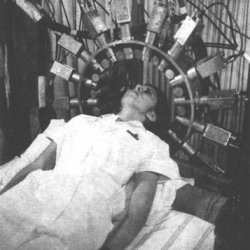 A positron emitter detector at
Brookhaven National Laboratory
(circa 1965).
A positron emitter detector at
Brookhaven National Laboratory
(circa 1965).
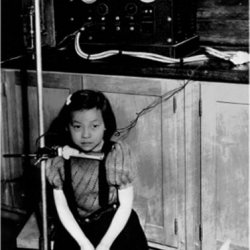 Early use of a Geiger-Muller counter to
test thyroid function at Lawrence
Radiation Laboratory.
Early use of a Geiger-Muller counter to
test thyroid function at Lawrence
Radiation Laboratory.
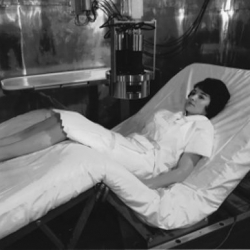 A conventional whole body counter (circa
1964).
A conventional whole body counter (circa
1964).
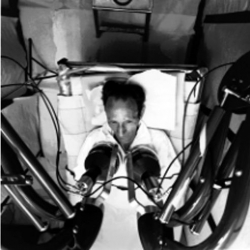 A counter being used at Los Alamos to
measure plutonium in the lung.
A counter being used at Los Alamos to
measure plutonium in the lung.
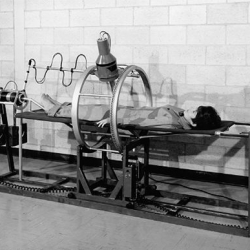 A horizontal rotational scanner used to detect
the quantity and distribution of radiation in the
body.
A horizontal rotational scanner used to detect
the quantity and distribution of radiation in the
body.
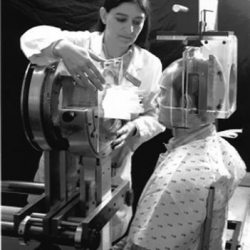 A patient prepared for treatment
with charged atomic particles at
Lawrence Radiation Laboratory.
A patient prepared for treatment
with charged atomic particles at
Lawrence Radiation Laboratory.
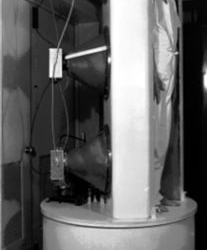 A whole body radiation
counter at Los Alamos
(circa 1958).
A whole body radiation
counter at Los Alamos
(circa 1958).
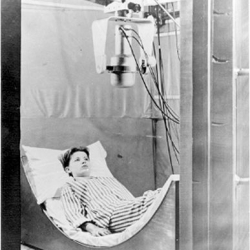 A whole body counter at Berkeley
Donner Laboratory (circa 1964). Such
counters were used human radiation
tracer studies and for measuring AEC
worker radiation exposure.
A whole body counter at Berkeley
Donner Laboratory (circa 1964). Such
counters were used human radiation
tracer studies and for measuring AEC
worker radiation exposure.
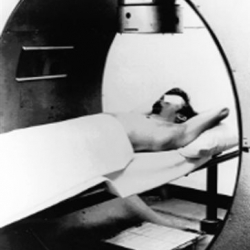 The automatic contouring system was
used at Argonne Research Cancer
Hospital to determine how much
radiation will penetrate to cancer
tumors.
The automatic contouring system was
used at Argonne Research Cancer
Hospital to determine how much
radiation will penetrate to cancer
tumors.
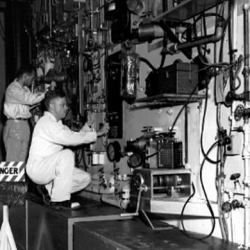 Production of isotopes at Oak Ridge National
Laboratory (circa 1946).
Production of isotopes at Oak Ridge National
Laboratory (circa 1946).
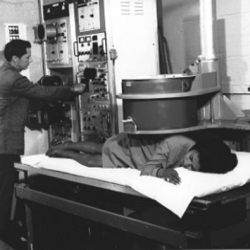 A patient under a positron camera. The camera
was a diagnostic tool developer at Berkeley's
Donner Laboratory to photograph radioactive tracer
concentrations. Unlike a whole body scanner, this
device photographs a single, specific area of the
body.
A patient under a positron camera. The camera
was a diagnostic tool developer at Berkeley's
Donner Laboratory to photograph radioactive tracer
concentrations. Unlike a whole body scanner, this
device photographs a single, specific area of the
body.
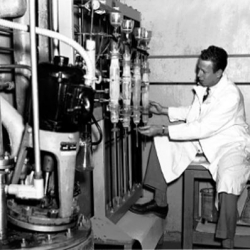 Separating radioactive carbon from material
bombarded in Oak Ridge nuclear reactor.
Separating radioactive carbon from material
bombarded in Oak Ridge nuclear reactor.
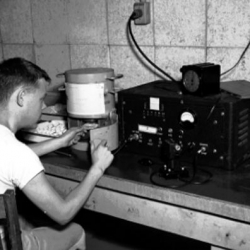 Measuring beta radiation from a sample of
phosphorus-32 at Oak Ridge.
Measuring beta radiation from a sample of
phosphorus-32 at Oak Ridge.
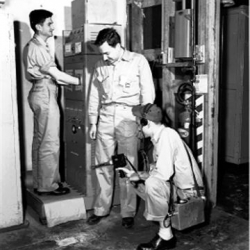 Oak Ridge National Laboratory
workers checking for radioactive
contaminants (circa 1950).
Oak Ridge National Laboratory
workers checking for radioactive
contaminants (circa 1950).
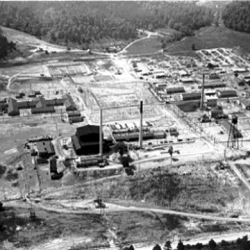 Aerial view of the Oak Ridge X-10 facility which
served as a pilot for the Hanford plutonium
production reactors (circa 1945). After World
War II, the facility produced isotopes for national
distribution.
Aerial view of the Oak Ridge X-10 facility which
served as a pilot for the Hanford plutonium
production reactors (circa 1945). After World
War II, the facility produced isotopes for national
distribution.
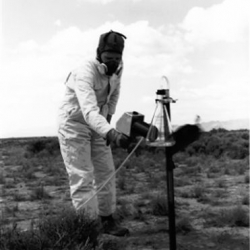 Measuring intentional radiation
release at the Idaho experimental
dairy farm (circa 1964).
Measuring intentional radiation
release at the Idaho experimental
dairy farm (circa 1964).
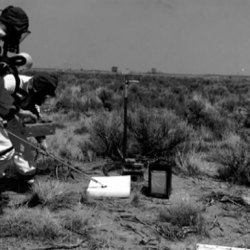 Checking radioactivity after a Controlled
Environmental Radioiodine Test (CERT) in
1966.
Checking radioactivity after a Controlled
Environmental Radioiodine Test (CERT) in
1966.
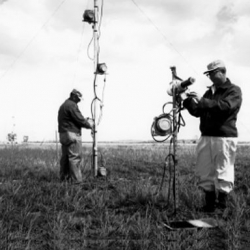 Measuring intentional radiation release at the
experimental Idaho dairy (circa 1964).
Measuring intentional radiation release at the
experimental Idaho dairy (circa 1964).
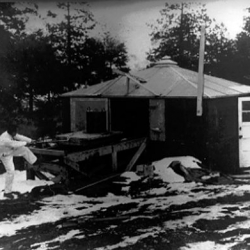 Early method of handling radioactive sources
at Los Alamos.
Early method of handling radioactive sources
at Los Alamos.
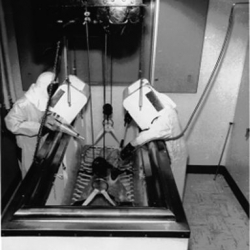 A facility at Hanford for treating persons
injured by embedded radioactive
particles (circa 1967). In this shielded
operating cell, a mock patient is flanked
by a surgeon, right, and a radiation
monitor, left.
A facility at Hanford for treating persons
injured by embedded radioactive
particles (circa 1967). In this shielded
operating cell, a mock patient is flanked
by a surgeon, right, and a radiation
monitor, left.
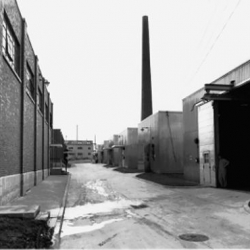 Isotope processing buildings at Oak Ridge.
Isotope processing buildings at Oak Ridge.
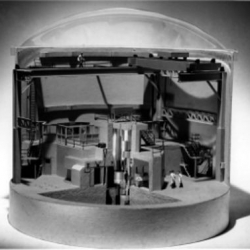 A subscale model of the nuclear reactor
used for medical research and treatment at
Brookhaven National Laboratory.
A subscale model of the nuclear reactor
used for medical research and treatment at
Brookhaven National Laboratory.
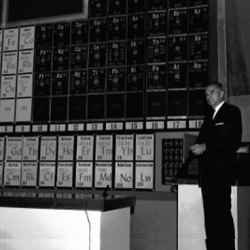 Glenn T. Seaborg, discoverer of plutonium
and chairman of the AEC from 1961 to 1971.
Glenn T. Seaborg, discoverer of plutonium
and chairman of the AEC from 1961 to 1971.
Exclusive 2019 Update: VICTORY AT THE VA – West LA Veterans Administration master plan protects old nuclear dump from development











































Recent Comments